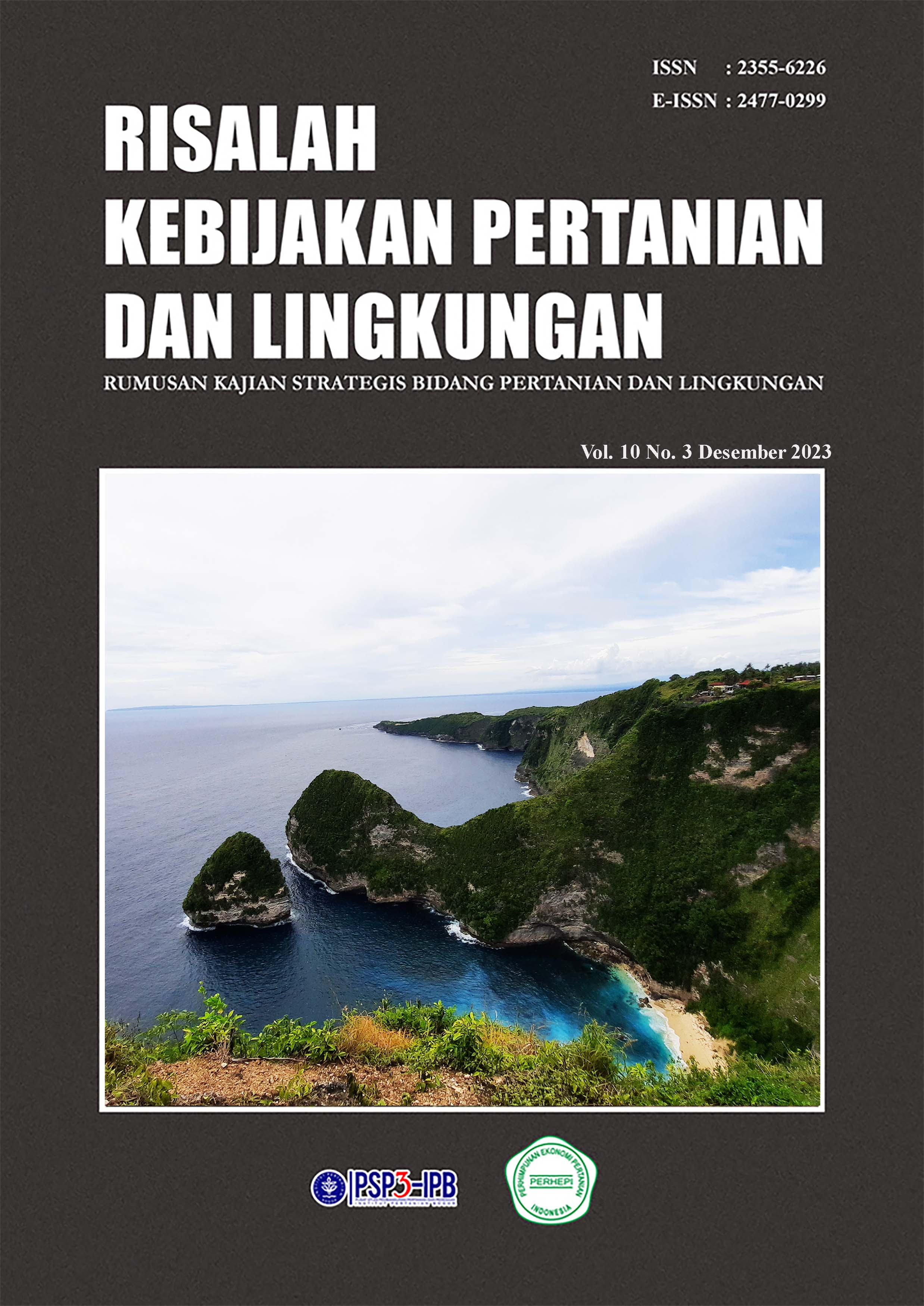DETERMINAN PRODUKSI DAN ANALISIS KELAYAKAN USAHATANI CABAI MERAH: STUDI KASUS DESA TANJUNG IBUS KECAMATAN SECANGGANG KABUPATEN LANGKAT
Abstract
The commodity that has the potential to be produced by farmers in Tanjung Ibus Village is red chilies. Limited and fluctuating availability and prices of production factors are problems in red chili production activities. Analysis of the determinants of red chili production is important as a policy recommendation to increase red chili production. The comparison of income and farming costs determines the feasibility of farming. Farming feasibility analysis is important to carry out in the development of red chilies. This research aims to analyze the determinants of production and feasibility of red chili farming in Tanjung Ibus Village, Secanggang District, Langkat Regency. The number of samples in this research was 42 farmers. This research uses the Cobb-Douglas production function analysis method and the B/C Ratio. The research results show that land, seeds, and fertilizer are production factors that significantly and positively influence red chili farming production. The B/C ratio value for red chili farming is 2.6, meaning that red chili farming in this study is feasible. The policy recommendations for this research are the establishment of a subsidy policy, fertilizer innovation with a combination of the use of chemical and non-chemical fertilizers, and assistance with tractor technology.
Metrics
Downloads
References
Adhiana. 2021. Analisis faktor-faktor yang mempengaruhi produksi cabai merah di Kabupaten Pidie Jaya. Jurnal Agrica Ekstensia, 15(1), 82-92.
Amelia, S., Putri M.A., Ibnusina, F. 2022. Karakteristik dan pengetahuan petani cabai merah terhadap penggunaan pestisida kimia: Studi kasus di Kecamatan Payakumbuh. Jurnal of Agri-food, 3(2), 133-142. https://doi.org/10.20961/agrihealth.v3i2.63032.
Amir, S.H. 2018. Analisis pendapatan usahatani cabai besar Varietas Pilar F1 di Kelurahan Tolo Utara Kecamatan Kelara Kabupaten Jeneponto. Skripsi, tidak dipublikasikan. Universitas Muhammadiyah Makassar.
Andayani, S.A. 2016. Faktor-faktor yang mempengaruhi produksi cabai merah. Mimbar Agribisnis, 1(3), 261-268. https://doi.org/10.25157/ma.v1i3.46.
Andrias, A.A., Darusman, Y., Ramdan, M. 2017. Pengaruh luas lahan terhadap produksi dan pendapatan usahatani padi sawah (Suatu kasus di Desa Jelat Kecamatan Baregbeg Kabupaten Ciamis. Jurnal Ilmiah Mahasiswa AGROINFO GALUH, 4(1), 521-529. http://dx.doi.org/10.25157/jimag.v4i1.1591.
Aprilyanti, S. 2017. Pengaruh usia dan masa kerja terhadap produktivitas kerja (Studi kasus: PT. Oasis Water International Cabang Palembang). Jurnal Sistem dan Manajemen Industri, 1(2), 68-72. http://dx.doi.org/10.30656/JSMI.V1I2.413.
[BPP] Balai Penyuluhan Pertanian. 2021. Rencana setahun dan realisasi setiap minggu luas lahan Kecamatan Secanggang. Laporan Mingguan.
Cahyadi, E.R., dan Hidayati, N. 2022. Peramalan dan penentuan target produksi kedelai nasional. Jurnal Risalah Kebijakan Pertanian dan Lingkungan, 9(1), 18-27. https://doi.org/10.29244/jkebijakan.v9i1.28035.
Dabutar, M., Husein, R. 2022. Pengaruh produksi, harga dan luas lahan terhadap pendapatan petani cabai merah di Indonesia. Jurnal Ekonomi Pertanian Unimal, 5(2), 42-52. https://doi.org/10.29103/jepu.v5i2.8721.
Hernawati, H. 2021. Analisis efisiensi teknis usahatani padi lahan irigasi di Kabupaten Lombok Barat. Risalah Kebijakan Pertanian dan Lingkungan, 8(2), 87-91. https://doi.org/10.29244/jkebijakan.v8i2.28037.
Hiskia, L.P. 2021. Analisis risiko produksi cabai merah di Kecamatan Rumbai Kota Pekanbaru. Skripsi, tidak dipublikasikan. Universitas Islam Riau.
Kantor Kepala Desa Tanjung Ibus. 2023. Karakteristik Penduduk Desa Tanjung Ibus Dari Dusun 1 Sampai 12. Desa Tanjung Ibus Kecamatan Secanggang Kabupaten Langkat Tahun 2023.
Kaswanto, R.L., Aurora, R.M., Yusri, D., Sjaf, S. Barus, S. 2021a. Kesesuaian lahan untuk komoditas unggulan pertanian di Kabupaten Labuhanbatu Utara. Analisis Kebijakan Pertanian, 19(2), 189-205. http://dx.doi.org/10.21082/akp.v19n2.
Kaswanto, R.L., Aurora, R.M., Yusri, D. dan Sjaf, S. 2021b. Analisis faktor pendorong perubahan tutupan lahan selama satu dekade di Kabupaten Labuhanbatu Utara. Jurnal Ilmu Lingkungan, 19(1), 107-116. https://doi.org/10.14710/jil.19.1.107-116.
Kurniati, S.A. 2020. Pengaruh karakteristik petani dan kompetensi terhadap kinerja petani padi sawah di Kecamatan Gunung Toar Kabupaten Kuantan Singingi. Jurnal Agribisnis, 22(1), 82-94. https://doi.org/10.31849/agr.v22i1.4042.
Nugraheni, S.S., Tinaprilla, N. 2022. Analisis pendapatan usahatani tumpang sari kentang di Kecamatan Pangalengan Kabupaten Bandung. Risalah Kebijakan Pertanian dan Lingkungan, 9(2), 123-132. https://doi.org/10.29244/jkebijakan.v9i2.34843.
Nurfalach, D.R. 2010. Budidaya tanaman cabai merah (Capsicum annum L.,) di UPTD perbibitan tanaman hortikultura Desa Pakopen Kecamatan Bandungan Kabupaten Semarang. Tugas Akhir, tidak dipublikasikan. Universitas Sebelas Maret.
Pradnyawati, I.G.A.B., Cipta, W. 2021. Pengaruh luas lahan, modal dan jumlah produksi terhadap pendapatan petani sayur di Kecamatan Baturiti. Ekuitas: Jurnal Pendidikan Ekonomi, 9(1), 93-100. https://doi.org/10.23887/ekuitas.v9i1.27562.
Prastiyo, Y.B., Kaswanto, R.L., Arifin, H.S. 2018. Plants production of agroforestry system in Ciliwung Riparian Landscape, Bogor Municipality. IOP Conference Series: Earth and Environmental, 179(1), 012013. https://doi.org/10.1088/1755-1315/179/1/012013.
Sarina, S., Silamat, E., Puspitasari, D. 2015. Analisis faktor-faktor yang mempengaruhi produksi cabai merah di Desa Kampung Melayu Kecamatan Bermani Ulu Kabupaten Rejang Lebong. AGROQUA. 13(2), 57-67.
Sitorus, R.J.F., Titiaryanti, N.M., Firmansyah, E. 2023. Pengaruh komposisi media tanam dan dosis pupuk NPK terhadap pertumbuhan dan hasil tanaman cabai merah (Capsicum annum L.). Agroforetech, 1(1), 161-166. https://jurnal.instiperjogja.ac.id/index.php/JOM/article/view/475.
Suratiyah, K. 2015. Ilmu usaha Tani (Edisi Revisi). Jakarta: Niaga swadaya.
Taufik, M. 2011. Analisis pendapatan usahatani dan penanganan pascapanen cabai merah. Jurnal Litbang Pertanian, 30 (12), 66-72. https://doi.org/10.21082/ jp3.v30n2.
Copyright (c) 2023 RISALAH KEBIJAKAN PERTANIAN DAN LINGKUNGAN: Rumusan Kajian Strategis Bidang Pertanian dan Lingkungan

This work is licensed under a Creative Commons Attribution 4.0 International License.
PUBLICATION ETHICS
Jurnal Risalah Kebijakan Pembangunan Pertanian dan Lingkungan (JRKPL) is a peer-reviewed journal publishing original research to develop a coherent and respected network of landscape architecture knowledge. JRKPL committed to upholding the highest standards of publication ethics that clarifies ethical behavior of all parties involved in publishing a scientific article in JRKPL.
As publisher of JRKPL, PSP3-LPPM IPB and PERHEPI takes its duties of guardianship all stages of publishing process and we recognize our ethical and other responsibilities.
Duties of Authors
An author should not publish manuscripts describing essentially the same research in more than one journal or primary publication. Submitting the same manuscript to more than one journal is unacceptable and constitutes unethical publishing behavior. In general, an author should not submit for consideration in another journal a previously published paper.
Authorship should be limited to those who have made a significant contribution to the manuscript and should be listed as co-authors. Where there are others who have participated in certain substantive aspects of the research project, they should be acknowledged as contributors. The corresponding author should ensure that all co-authors have seen and approved the final version of the paper and have agreed to its submission for publication.
The authors should ensure that they have written entirely original works, and if the authors have used the work and/or words of others, that this has been appropriately cited or quoted. Plagiarism are include passing off another paper as the author own paper, copying or paraphrasing substantial parts of another paper (without attribution) and claiming results from research conducted by others. Plagiarism constitutes unethical publishing behavior and is unacceptable. Plagiarism detected works will be banned for further publication procedure.
The authors acknowledge that they have disclosed all and any actual or potential conflicts of interest with their work or partial benefits associated with it. All sources of financial support for the project should be disclosed. Potential conflicts of interest should be disclosed at the earliest stage possible.
Duties of the Editorial Board
Review Process
JRKPL is committed to objective and fair double-blind peer-review to prevent any actual or potential conflict of interests between the editorial and review personnel and the reviewed material. JRKPL chooses reviewers based on their expertise (whose most closely matches the topic of the paper). At least 2 reviewers are invited to evaluate a manuscript. In cases of controversy or disagreement regarding the merits of the work, an additional review will be solicited. The JRKPL editor mediates all interaction between authors and reviewers, and the review results owned by JRKPL.
Publication Decisions
The editor of a peer-reviewed JRKPL is responsible for deciding which of the articles submitted to the journal should be published. The validation of the work in question and its importance to researchers and readers must always drive such decisions. The final decision on article acceptance based on reviewer's opinions, suggestions, and comments. The editor may confer with other editors or reviewers in making this decision.
Fair Play
JRKPL evaluates manuscripts only based on the intellectual content. No race, gender, sexual orientation, religious belief, ethnic origin, citizenship, or political philosophies of the authors are considered in the evaluation process.
Confidentiality
JRKPL assure the confidentially of the manuscripts, actors, and other related information on the publishing process. Only corresponding author, reviewers, potential reviewers, other editorial advisers, and the publisher are allows for the information.
Disclosure
Unpublished materials disclosed in a submitted manuscript must not be used in an editor's own research without the express written consent of the author. Privileged information or ideas obtained through peer review must be kept confidential and not used for personal advantage.
Duties of reviewers
(1) Objectivity: Reviewer should provide written and unbiased feedback to the authors, personal criticism of the author is inappropriate. Reviewer comments should be clearly with supporting arguments indicating whether the writing is concise and relevant
(2) Expertise: Reviewer who feels unqualified to review the research reported in a manuscript or knows that its prompt review will be impossible should notify the editor and excuse himself from the review process.
(3) Acknowledgement of sources: Reviewer suggest relevant published work that has not been cited by the authors to improve the quality of the manuscript,
(4) Confidentiality: Reviewer should maintain the confidentiality of the review process. Privileged information or ideas obtained through peer review must be kept confidential and not used for personal advantage.
(5) Disclosure and conflict of interest: Unpublished materials disclosed in a submitted manuscript must not be used in a reviewer own research without the express written consent of the author. Reviewers should not consider manuscripts in which they have conflicts of interest resulting from competitive, collaborative, or other relationships or connections with any of the authors, companies, or institutions connected to the papers.






















